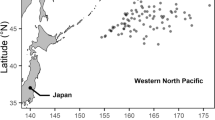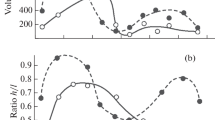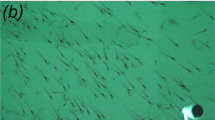Abstract
All the fish in a school occupy a volume estimated as N·BL3, where N is the number of fish and BL is their mean body length. We present extensive data from our experiments on cruising schools of saithe (Pollachius virens), herring (Clupea harengus) and cod (Gadus morhua) to validate this formula. Two methods of calculating the volumes of schools are described. One method is aggregative and depends on measuring the envelope of free space around a schooling fish, whereas the other is based on the dimensions of the school as a whole. The whole-school method is more reliable since it includes lacunae between the sub-units which exist in schools. For this method, we derive a computation which eliminates bias from outliers. The most realistic theoretical aggregative packing model predicts a volume per fish of 0.6 BL3. In saithe, the envelope of free space is approximately an ellipsoid, which, although it becomes more compressed at higher swimming speeds, yields a volume close to 0.7 BL3. From the whole-school method we calculate average volumes of 1.4 BL3 for saithe and 0.7 BL3 for herring. Increase in swimming speed produces more compact schools in saithe, but changes in arousal level can generate equally large differences. Changes in volume were not adequately explained by changes in nearest neighbour distance, giving support to the whole-school method.
Similar content being viewed by others
Literature Cited
Bateson, W.: The sense organs and perceptions of fish; with remarks on the supply of bait. J. mar. biol. Ass. U.K. 1, 225–256 (1889)
Breder, C.M.: Equations descriptive of fish schools and other animal aggregations. Ecology 35, 361–370 (1954)
—: Studies of social groupings in fishes. Bull. Am. Mus. nat. Hist. 117, 397–481 (1959)
—: Fish schools as operational structures. Fish. Bull. U.S. 74, 471–502 (1976)
Cullen, J.M., E. Shaw and H. Baldwin: Methods for measuring the 3-D structure of fish schools. Anim. Behav. 13, 534–543 (1965)
Cushing, D.H.: Direct estimation of a fish population acoustically. J. Fish. Res. Bd Can. 25, 2349–2364 (1968)
—: Observations on fish schools with the ARL scanner. Rapp. P.-V. Réun. Cons. perm. int. Explor. Mer 170, 15–20 (1977)
— and F.R. Harden-Jones: Why do fish school? Nature, Lond. 218, 918–920 (1968)
Graves, J.: Photographic method for measuring spacing and density within pelagic fish schools at sea. Fish Bull. U.S. 75, 230–233 (1977)
Hamilton, W.D.: Geometry for the selfish herd. J. theor. Biol. 31, 295–311 (1971)
Hewitt, R.P., P.E. Smith and J.C. Brown: Developments and use of sonar mapping for pelagic stock assessment in the California current area. Fish. Bull. U.S. 74, 281–300 (1976)
Holliday, D.V.: Two applications of the Doppler effect in the study of fish schools. Rapp. P.-v. Réun. Cons. perm. int. Explor. Mer 170, 21–30 (1977)
Hunter, J.R.: Procedure for analysis of schooling behavior. J. Fish. Res. Bd Can. 23, 547–562 (1966)
Keenleyside, M.: Aspects of schooling behaviour in fish. Behaviour 8, 83–248 (1955)
Kendall, M.G. and P.A.P. Moran: Geometrical probability, 125 pp. London: C. Griffin 1963
Parr, E.A.: A contribution to the theoretical analysis of the schooling behavior of fishes. Occ. Pap. Bingham oceanogr. Colln 1, 1–32 (1927)
Partridge, B.L.: Sensory aspects of schooling, 550 pp. Dissertation, University of Oxford 1978
Partridge, B.L.: The effects of size on the 3-D structure of minnow schools. Anim. Behav. (In press). (1979)
— and T.J. Pitcher: Evidence against the hydrodynamical function of fish schools. Nature, Lond. 279, 418–419 (1979)
Partridge, B.L., T.J. Pitcher, J.M. Cullen and J. Wilson: The three dimensional structure of fish schools. Behavl Ecol. Sociobiol. (In press). (1979)
Pitcher, T.J.: The 3-dimensional structure of schools in the minnow, Phoxinus phoxinus. Anim. Behav. 21, 673–686 (1973)
—: A periscopic method for determining the 3-D positions of fish in schools. J. Fish. Res. Bd Can. 32, 1533–1538 (1975)
—: Sensory information and the organisation of behaviour in a shoaling cyprinid fish. Anim. Behav. 27, 126–149 (1979)
Pitcher, T.J. and B.L. Partridge: The structure, sensory basis and sociobiology of fish schools. New Scient. (In press). (1979)
—— and C.S. Wardle: A blind fish can school. Science, N.Y. 194, 963–965 (1976)
Radakov, D.V.: Schooling in the ecology of fish, 173 pp. New York: John Wiley & Sons 1973. (Israeli Translation Series)
Rottingen, I.: On the relation between echo intensity and fish density. FiskDir. Skr. (Ser. Havunders.) 16, 301–314 (1976)
Serebrov, L.I.: Relationship between school density and size of fish. J. Ichthyol. 15, 135–140 (1976)
Shaw, E.: The development of schooling behaviour in fishes. Physiol. Zoöl. 33, 79–86 (1960)
—: The optomotor response and the schooling of fish. Spec. Publs int. Commn NW. Atlant. Fish. 6, 753–779 (1965)
Smith, P.E.: The horizontal dimensions and abundance of fish schools in the upper mixed layer as measured by sonar. In: Proceedings of an International Symposium on Biological Sound Scattering in the Ocean, pp 563–591 Ed. by G.B. Farquhar. Washington, D.C.: Department of the Navy 1970
Squire, J.L.: Northern anchovy school shapes as related to problems in school size estimation. Fish. Bull. U.S. 76, 443–448 (1978)
Symons, P.E.: Spacing and density of schooling three spine sticklebacks (Gasterosteus aculeatus) and mummichog (Fundulus heteroclitus). J. Fish. Res. Bd Can. 28, 999–1004 (1971)
Treisman, M.: Predation and the evolution of gregariousness. I. Models of concealment and evasion. Anim. Behav. 23, 779–800 (1975)
Truskanov, M.D. and M.N. Scherbino: Methods of direct calculation of fish concentrations by means of hydroacoustic apparatus, paper presented to the Seminar on Fishery Biology and Oceanography, Moscow (1964); [Translation as Appendix 2, pp 594–600, in Smith (1970)]
Weihs, D.: Hydrodynamics of fish schooling. Nature, Lond. 241, 290–291 (1973)
—: Some hydrodynamical aspects of fish schooling. In: Proceedings of a Symposium on Swimming and Flying in Nature, held at Pasadena, Calif., July, 1974, pp 297–311. Ed. by T. Wu et al. New York: Plenum Press 1975
Author information
Authors and Affiliations
Additional information
Communicated by N.D. Holland, La Jolla
Rights and permissions
About this article
Cite this article
Pitcher, T.J., Partridge, B.L. Fish school density and volume. Mar. Biol. 54, 383–394 (1979). https://doi.org/10.1007/BF00395444
Accepted:
Issue Date:
DOI: https://doi.org/10.1007/BF00395444




